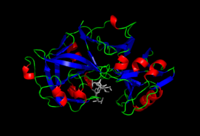
Photo from wikipedia
The toxicity of mercury is often attributed to its tight binding to cysteine thiolate anions in vital enzymes. To test our hypothesis that Hg(II) binding to histidine could be a… Click to show full abstract
The toxicity of mercury is often attributed to its tight binding to cysteine thiolate anions in vital enzymes. To test our hypothesis that Hg(II) binding to histidine could be a significant factor in mercury's toxic effects, we studied the enzyme chymotrypsin, which lacks free cysteine thiols; we found that chymotrypsin is not only inhibited, but also denatured by Hg(II). We followed the aggregation of denatured enzyme by the increase in visible absorbance due to light scattering. Hg(II)‐induced chymotrypsin precipitation increased dramatically above pH 6.5, and free imidazole inhibited this precipitation, implicating histidine‐Hg(II) binding in the process of chymotrypsin denaturation/aggregation. Diethylpyrocarbonate (DEPC) blocked chymotrypsin's two histidines (his40 and his57) quickly and completely, with an IC50 of 35 ± 6 µM. DEPC at 350 µM reduced the hydrolytic activity of chymotrypsin by 90%, suggesting that low concentrations of DEPC react with his57 at the active site catalytic triad; furthermore, DEPC below 400 µM enhanced the Hg(II)‐induced precipitation of chymotrypsin. We conclude that his57 reacts readily with DEPC, causing enzyme inhibition and enhancement of Hg(II)‐induced aggregation. Above 500 µM, DEPC inhibited Hg(II)‐induced precipitation, and [DEPC] >2.5 mM completely protected chymotrypsin against precipitation. This suggests that his40 reacts less readily with DEPC, and that chymotrypsin denaturation is caused by Hg(II) binding specifically to the his40 residue. Finally, we show that Hg(II)‐histidine binding may trigger hemoglobin aggregation as well. Because of results with these two enzymes, we suggest that metal‐histidine binding may be key to understanding all heavy metal‐induced protein aggregation.
Journal Title: Protein Science
Year Published: 2017
Link to full text (if available)
Share on Social Media: Sign Up to like & get
recommendations!